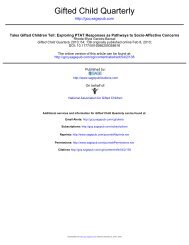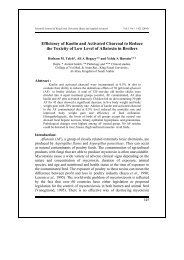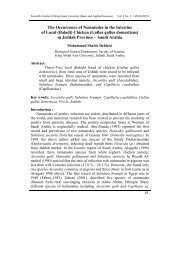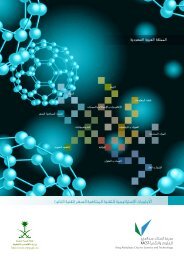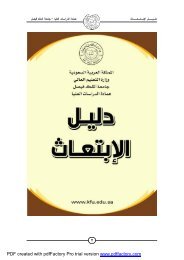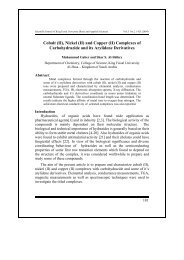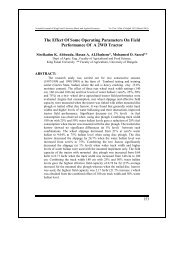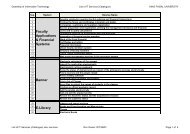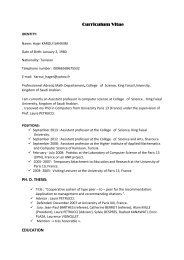Comparison of Antifungal Activity of Thymoquinone and ...
Comparison of Antifungal Activity of Thymoquinone and ...
Comparison of Antifungal Activity of Thymoquinone and ...
Create successful ePaper yourself
Turn your PDF publications into a flip-book with our unique Google optimized e-Paper software.
Scientific Journal <strong>of</strong> King Faisal University (Basic <strong>and</strong> Applied Sciences) Vol. 8 No. 2 1428H (2007) <strong>Comparison</strong> <strong>of</strong> <strong>Antifungal</strong> <strong>Activity</strong> <strong>of</strong> <strong>Thymoquinone</strong> <strong>and</strong>Amphotericin B Against Fusarium solani in-vitro.Naeem Akhtar, Omar Mohamad Alakloby * , Salih Hamad Mohamad Aljabre *Abdul Rahman Mohamad Alqurashi, Mohammad Akram R<strong>and</strong>hawa **Department <strong>of</strong> Microbiology, * Department <strong>of</strong> Dermatology,** Department <strong>of</strong> Pharmacology, College <strong>of</strong> Medicine,King Faisal University, Dammam, Saudi Arabia.Abstract:The activity <strong>of</strong> thymoquinone, an active principle <strong>of</strong> Nigella sativa, <strong>and</strong>amphotericin B was compared against a clinical isolate <strong>of</strong> Fusarium solani. Theorganism was isolated from a nail lesion <strong>of</strong> an immunocompetent adult male inroutine fungal culture on dermasel agar. For susceptibility testing the organismwas grown on two sets <strong>of</strong> dermasel agar containing, 1.0, 0.5, 0.25, 0.125, 0.062& 0.031 mg <strong>of</strong> thymoquinone <strong>and</strong> amphotericin B/ml. It was grown on dermaselagar alone as control. The growth on 10 th day <strong>of</strong> inoculation was recorded as %inhibition taking growth <strong>of</strong> control as 100%.There was 0, 2.0, 3.0, 18.3, 59.3, <strong>and</strong> 100% inhibition <strong>of</strong> growth <strong>of</strong>Fusarium solani with 0.031, 0.062, 0.125, 0.25, 0.5, 1.0 mg thymoquinone /mlon 10th day <strong>of</strong> incubation. At similar concentrations <strong>of</strong> amphotericin B, therewas 6.2, 24.5, 31.2, 39.7, 54.4 <strong>and</strong> 72.4% inhibition <strong>of</strong> growth. There was nocomplete inhibition <strong>of</strong> growth at any concentration <strong>of</strong> the drug.The study shows that at higher concentrations thymoquinone, giving a steapdose-effect relationship, more effectively inhibited the growth <strong>of</strong> a clinicalisolate <strong>of</strong> Fusarium solani as compared to amphotericin B which gave shallowdose-effect relationship. However, amphotericin B was better at lowerconcentrations.Key words: Nigella sativa, thymoquinone, amphotericin B, Fusarium solaniIntroduction:Nigella sativa called as Habbah Al-Sauda in Arabic, is commonly used as anatural remedy for many ailments over 2000 years <strong>and</strong> is frequently added tobread <strong>and</strong> prickles as a flavouring agent (Al-Kadi & K<strong>and</strong>il, 1986). Manyactive principles have been isolated from N. sativa seed includingthymoquinone, thymohydroquinone, dithymoquinone, thymol, carvacrol,nigellicine, nigellidine, nigellimine-N-oxide <strong>and</strong> alpha-hedrin (Al-Dakhakhany,1963; Ata-ur-Rahman et al., 1985; Ata-ur-Rahman & Malik, 1995; Kumara &Huat, 2001). Besides many other pharmacological effects, activity <strong>of</strong> N.sativa137
<strong>Comparison</strong> <strong>of</strong> <strong>Antifungal</strong> <strong>Activity</strong> <strong>of</strong> <strong>Thymoquinone</strong> …Naeem Akhtar et. al.volatile oil, ether extract <strong>and</strong> its active principle thymohydroquinone has beenreported in the literature against a number <strong>of</strong> bacteria (includingStaphylococcus aureus, Pseudomonas aeruginosa & Escherichia coli) <strong>and</strong>fungi like C<strong>and</strong>ida albicans & Aspergillus niger (Topozada et al. 1965; El-Fatatry, 1975; Hanafi & Hatem, 1991; Morsi, 2000; Al-Jabre et al., 2003).Fusarium solani is a filamentous mold. Even though filamentous molds areubiquitous in the environment, only over the past two decades have suchsaprophytic fungi emerged as a major threat in patients with compromised hostdefenses, such as those with hematologic malignancies <strong>and</strong> bone marrowtransplant recipients (Anaissie et al., 1989; Marr et al., 2002; Kontoyiannis &Bodey, 2002). Aspergillus is by far the most common mold causing severeinfections. However, Fusarium spp., have been increasingly recognized aslethal pathogens in these patients after invasive aspergillosis (Anaissie et al.,1989; Marr et al., 2002; Nelson et al., 1994; Martino et al., 1994; Boutati &Anaissie, 1997; Girmenia et al., 2000).The skin <strong>and</strong> respiratory tract are the primary portals <strong>of</strong> entry for Fusariuminfection (Nelson et al., 1994; Guarro & Gene, 1995; Musa et al., 2000).Localized skin <strong>and</strong> nail infections have also been associated with subsequentdissemination <strong>of</strong> Fusarium species when the patient becomes neutropenicduring the course <strong>of</strong> immunosuppressive treatment (Gupta et al., 2000).Hospital water distribution systems have recently been implicated as sources <strong>of</strong>nosocomial fusariosis (Anaissie et al., 2001).Keeping in view the antibacterial <strong>and</strong> anti-aspergillus activity we thoughtthat N. sativa or some <strong>of</strong> its active principles might have useful activity againstFusarium solani, a relatively resistant opportunistic fungus. In this study, theactivity <strong>of</strong> thymoquinone against Fusarium solani was compared to that <strong>of</strong>amphotericin B in vitro.Materials <strong>and</strong> Methods:Fusarium solani was isolated from a nail clipping from an adultimmunocompetent male with clinical diagnosis <strong>of</strong> onycomycosis. Thespecimen was cultured on dermasel agar (Oxoid) in the Department <strong>of</strong>Microbiology, College <strong>of</strong> Medicine, King Faisal University, Dammam, SaudiArabia. The plates were incubated at 30 O C for 10 days. The growth wasidentified as Fusarium solani by colonial morphology <strong>and</strong> by microscopy afterstaining with lactophenol cotton blue. 138
Scientific Journal <strong>of</strong> King Faisal University (Basic <strong>and</strong> Applied Sciences) Vol. 8 No. 2 1428H (2007) Preparation <strong>of</strong> Reagents & Media:<strong>Thymoquinone</strong> (Sigma, USA) <strong>and</strong> amphotericin B (Sigma, USA) wereseparately dissolved in 4 ml <strong>of</strong> dimethyl sulphoxide (DMSO) (Sigma, USA)<strong>and</strong> then serially diluted in dermasel agar to give final concentrations <strong>of</strong> 1.0,0.5, 0.25, 0.125, 0.06 & 0.031 mg/ml. Four plates <strong>of</strong> each concentration wereprepared. Four plates <strong>of</strong> dermasel agar containing the same concentrations <strong>of</strong>DMSO as in the treated plates, alone were used as a control.Susceptibilty Testing:Susceptibility testing was carried out as previously described (Ali-Shtayeh& Abu-Ghdeib, 1999). A mycelial disc <strong>of</strong> clinical isolate <strong>of</strong> Fusarium solani, 5mm in diameter, cut from the periphery <strong>of</strong> 7 days old culture in dermasel agarwas aseptically inoculated onto each set <strong>of</strong> above mentioned plates. Theinoculated plates were incubated at 30 O C for 10 days. The growth wasexamined on 4 th <strong>and</strong> 7 th days <strong>and</strong> finally reported on 10 th day <strong>of</strong> inoculation <strong>and</strong>results interpreted by measurement <strong>of</strong> the mean diameter <strong>of</strong> the growth. Thepercentage inhibitions <strong>of</strong> Fusarium solani with different concentrations <strong>of</strong>thymoquinone <strong>and</strong> amphotericin B were then calculated by taking its growthon non-drug dermasel agar as 100%.Statistical Analysis:The results <strong>of</strong> thymoquinone <strong>and</strong> amphotericin B were comparedstatistically using students "t" test <strong>and</strong> P-values determined for the differencesbetween the means ±se <strong>of</strong> corresponding concentrations <strong>of</strong> thymoquinone <strong>and</strong>amphotericin B.Results:Percentage inhibitions <strong>of</strong> growth <strong>of</strong> Fusarium solani with 0.031, 0.062,0.125, 0.25, 0.5, 1.0 mg thymoquinone <strong>and</strong> amphotericin B /ml on 10 th day <strong>of</strong>incubation are shown in table 1. Growth on the control plates on respectivedays was considered as 100%. There was complete inhibition <strong>of</strong> growth at 1.0mg thymoquinone/ml <strong>and</strong> there was no complete inhibition <strong>of</strong> growth at anyconcentration <strong>of</strong> amphotericin B. At higher concentrations (0.5-1.0 mg/ml),thymoquinone, giving a steap dose-effect relationship, more effectivelyinhibited the growth <strong>of</strong> a clinical isolate <strong>of</strong> Fusarium solani as compared toamphotericin B, which gave a rather shallow dose-effect relationship.However, amphotericin B was better at lower concentrations (0.031-0.25mg/ml).139
<strong>Comparison</strong> <strong>of</strong> <strong>Antifungal</strong> <strong>Activity</strong> <strong>of</strong> <strong>Thymoquinone</strong> …Naeem Akhtar et. al.140Table ( 1 )Percentage inhibition <strong>of</strong> growth <strong>of</strong> Fusarium solani with differentconcentrations <strong>of</strong> thymoquinone <strong>and</strong> amphotericin B after 10 days <strong>of</strong>incubation.Concentrations(mg/ml)0.0310.0620.1250.250.51.0% inhibition <strong>of</strong> growth<strong>Thymoquinone</strong>(Mean ±se)0 ± 02.0 ±13.0 ±0.2518.3 ±1.4559.3 ±3.93100 ±0Amphotericin B(Mean ±se)6.2 ±0.7624.5 ±0.9231.2 ±0.6539.7 ±1.2254.4 ±2.7272.4 ±2.12*P-values fromstudents "t" test
Scientific Journal <strong>of</strong> King Faisal University (Basic <strong>and</strong> Applied Sciences) Vol. 8 No. 2 1428H (2007) Fusarium is one <strong>of</strong> the most resistant fungi to the arsenal <strong>of</strong> modernantifungal agents. Current therapeutic approaches for fusariosis are suboptimal,resulting in exceedingly high mortality rates (Anaissie, 1989; Martino, 1994;Boutati & Anaissie, 1997; Girmenia et al., 2000; Torres & Kontoyiannis 2003).The mainstay in the treatment <strong>of</strong> fusariosis has traditionally been amphotericinB. However, the in vitro susceptibility <strong>of</strong> Fusarium species to amphotericin Bis, at best, mediocre (Anaissie, 1989; Boutati & Anaissie, 1997). The activity<strong>of</strong> amphotericin B in animal models <strong>of</strong> fusariosis is also limited (Anaissie etal., 1992; Guarro et al., 1999). In fact, only high doses <strong>of</strong> liposomalamphotericin B have been shown to be active against Fusarium species inanimal models using immunocompetent mice (Ortoneda et al., 2002).Further investigations <strong>of</strong> usefulness <strong>of</strong> N. sativa <strong>and</strong> its active principles inthe treatment <strong>of</strong> opportunistic fungal infections like fusariosis should beconsidered.141
<strong>Comparison</strong> <strong>of</strong> <strong>Antifungal</strong> <strong>Activity</strong> <strong>of</strong> <strong>Thymoquinone</strong> …Naeem Akhtar et. al.References:1. Al-Kadi A & K<strong>and</strong>il O. (1986). Effect <strong>of</strong> Nigella sativa (the black seed) onimmunity. Proceedings <strong>of</strong> the 4 th International Conference on Islamic Medicine,Kuwait. Bulletin <strong>of</strong> Islamic Medicine 4, 344-348.2. Al-Dakhakhany M. (1963). Studies on the chemical constituition <strong>of</strong> EgyptianNigella sativa L seeds. Planta Med 1, 465-470.3. Ata-ur-Rahman, Malik SO, Ahmed S, Chaudhry I, habib-ur-Rehman (1985).Nigellimine-N-Oxide, a new isoquinoline alkaloid from seeds <strong>of</strong> Nigella sativa.Heterocycles 23, 953-955.4. Ata-ur-Rahman, & Malik SO. (1995). Nigellidine, a new indazole alkaloid fromseeds <strong>of</strong> Nigella sativa. J Res Inst 36, 1993-1996.5. Kumara SS & Huat BT. (2001). Extraction, isolation <strong>and</strong> characterization <strong>of</strong> antitumourprinciple, alpha-hedrin, from seeds <strong>of</strong> Nigella sativa. Planta Med 67, 29-32.6. Topozada HH, Masloum H & Al-Dakhakhany M. (1965). The antibacterialproperties <strong>of</strong> Nigella sativa seeds: active principle with some applications. J EgypMed Asso 48 (suppl), 187-202.7. El-Fatatry (1975). Isolation <strong>and</strong> structural assignment <strong>of</strong> an anti-microbialprinciple from the volatile oil <strong>of</strong> Nigella sativa L seeds. Pharmazie 30, 109-111.8. Hanafi MS & Hatem ME. (1991). Studies on the anti-microbial activity Nigellasativa seed (black cumin). J Ethnopharmacol 34, 275-278.9. Morsi (2000). Antimicrobial effect <strong>of</strong> crude extracts <strong>of</strong> Nigella sativa on multipleantibiotic resistant bacteria. Acta Microbiol 49, 63-74.10. Al-Jabre S, Al-Akloby Om, Al-Qurashi AR, Akhtar N, Al-Dossary A, R<strong>and</strong>hawaMA (2003). <strong>Thymoquinone</strong>, an active principle <strong>of</strong> Nigella sativa, inhibitedAspergillus niger. Pakistan J Med Res 42, 103-104.11. Anaissie EJ, Bodey GP & Rinaldi MG. (1989). Emerging fungal pathogens. Eur JClin Microbiol Infect Dis 8, 323-330.12. Marr KA, Carter RA, Crippa F, Wald A, Corey L (2002). Epidemiology <strong>and</strong>outcome <strong>of</strong> mould infections in hematopoietic stem cell transplant recipients. ClinInfect Dis 34, 909-917.13. Kontoyiannis DP & Bodey GP. (2002). Invasive aspergillosis in 2002: an update.Eur J Clin Microbiol Infect Dis 21, 161-172.14. Nelson PE, Dignani MC & Anaissie EJ. (1994). Taxonomy, biology, <strong>and</strong> clinicalaspects <strong>of</strong> Fusarium species. Clin Microbiol Rev 7, 479-504.15. Martino P, Gastaldi R, Raccah R, Girmenia C (1994). Clinical patterns <strong>of</strong>Fusarium infections in immunocompromised patients. J Infect 28 (suppl 1), 7-15.16. Boutati EI & Anaissie EJ. (1997). Fusarium, a significant emerging pathogen inpatients with hematologic malignancy: ten years' experience at a cancer center <strong>and</strong>implications for management. Blood 90, 999-1008. 142
Scientific Journal <strong>of</strong> King Faisal University (Basic <strong>and</strong> Applied Sciences) Vol. 8 No. 2 1428H (2007) 17. Girmenia C, Pagano L, Corvatta L, Mele L, del Favero A, Martino P (2000). Theepidemiology <strong>of</strong> fusariosis in patients with haematological diseases. GimemaInfection Programme. Br J Haematol 111, 272-276.18. Guarro J & Gene J. (1995). Opportunistic fusarial infections in humans. Eur J ClinMicrobiol Infect Dis 14, 741-754.19. Musa MO, Al Eisa A, Halim M, Sahovic, Gyger, Chaudhri, Al Mohareb, Seth,Aslam, Alju (2000). The spectrum <strong>of</strong> Fusarium infection in immunocompromisedpatients with haematological malignancies <strong>and</strong> in non-immunocompromisedpatients: a single institution experience over 10 years. Br J Haematol 108, 544-54820. Gupta AK, Baran R & Summerbell RC. (2000). Fusarium infections <strong>of</strong> the skin.Curr Opin Infect Dis 13, 121-128.21. Anaissie EJ, Kuchar RT, Rex JH, Francesconi A, Kasai M, Müller FC, Lozano-Chiu M, Summerbell RC, Dignani MC, Chanock SJ, Walsh TJ(2001). Fusariosisassociated with pathogenic Fusarium species colonization <strong>of</strong> a hospital watersystem: a new paradigm for the epidemiology <strong>of</strong> opportunistic mold infections.Clin Infect Dis 33, 1871-1878.22. Ali-Shtayeh MS & Abu-Ghdeib SI. (1999). <strong>Antifungal</strong> activity <strong>of</strong> plant extractsagainst dermatophytes. Mycoses 42, 665-672.23. Al-Jishi SAA (2000). A study <strong>of</strong> Nigella sativa on blood hemostatic functions.MSc Thesis, Department <strong>of</strong> Physiology, King Faisal University, Dammam, SaudiArabia.24. Al-Syed MM, El-Banna HA & Fathy FA. (1994). The use <strong>of</strong> Nigella sativa oil asa natural preservative agent in processed cheese spread. Egyp J Food Sci 22, 381-396.25. Lewis RE, Wiederhold NP, Klepser ME. (2005) . In Vitro Pharmacodynamics <strong>of</strong>Amphotericin B, Itraconazole, <strong>and</strong> Voriconazole against Aspergillus, Fusarium,<strong>and</strong> Scedosporium spp. Antimicrob Agents Chemother 49, 945-951.26. Bekersky I, Fielding RM, Dressler DE, Lee JW, Buell DN, Walsh TJ. (2002).Plasma protein binding <strong>of</strong> amphotericin B <strong>and</strong> pharmacokinetics <strong>of</strong> bound versusunbound amphotericin B after administration <strong>of</strong> intravenous liposomalamphotericin B (AmBisome) <strong>and</strong> amphotericin B deoxycholate. Antimicrob.Agents Chemother. 46, 834-840.27. Torres HA & Kontoyiannis DP. (2003). Hyalohyphomycoses (other thanAspergillosis <strong>and</strong> Penicilliosis). In: Dismukes WE, Pappas PG, Sobel JD, eds.Oxford Textbook <strong>of</strong> Clinical Mycology. 1st ed. New York: Oxford UniversityPress, 252-270.28. Anaissie EJ, Hachem R, Legr<strong>and</strong> C, Legenne P, Nelson P, Bodey GP (1992). Lack<strong>of</strong> activity <strong>of</strong> amphotericin B in systemic murine fusarial infection. J Infect Dis165, 1155-1157.29. Guarro J, Pujol I & Mayayo E. (1999). In vitro <strong>and</strong> in vivo experimental activities<strong>of</strong> antifungal agents against Fusarium solani . Antimicrob Agents Chemother 43,1256-1257.143
<strong>Comparison</strong> <strong>of</strong> <strong>Antifungal</strong> <strong>Activity</strong> <strong>of</strong> <strong>Thymoquinone</strong> …Naeem Akhtar et. al.אאאאא144(א(אאמGG ، א، א، GGאא،אאGGG א ،א ،א א–אא،אאא אW אאW אאאאאאאאאEאFא אא Wאא אKאאאאאאאאא٠{٥ ١W א א א אא אK Kא ٠{٠٣١ ٠{٠٦٢ ٠{٢٥אאא אKא אאW ٥٩{٣١٨{٣٣٢{٠אאאאא٠{٥٠{٠٢٥٠{١٢٥٠{٠٦٢٠{٣١אאא ٪١٠٠אא א١Kאאא ٧٢{٤٥٤{٤٣٩{٧٣١{٢٢٤{٥٦{٢ Kא
Scientific Journal <strong>of</strong> King Faisal University (Basic <strong>and</strong> Applied Sciences) Vol. 8 No. 2 1428H (2007) אW אא אאאאאאאא EאFא Kא145



